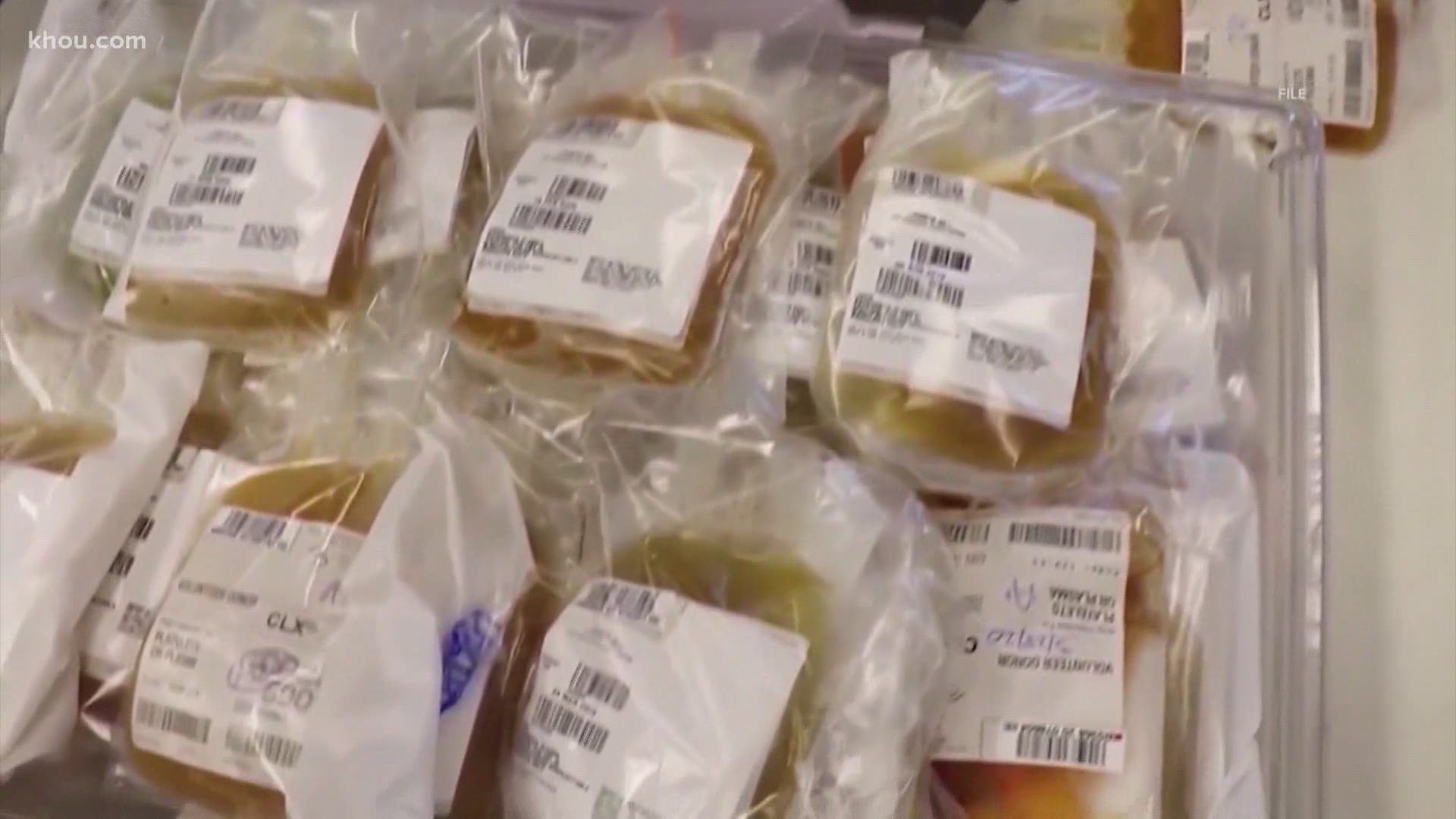AUSTIN, Texas — A COVID-19 treatment given to patients facing death is in short supply.
Doctors need COVID-19 convalescent plasma. It’s plasma from recovered COVID-19 patients which may help a critically ill patient fight the virus.
Patients like Sarah Ayala at Mission Regional Medical Center in South Texas.
“She told me, 'Promise me you won't leave me alone.’ She was crying,” said Robert Elizondo, Ayala’s husband.
Death was on both of their minds.
“She said, 'If I die, don't let them throw me away. You'd better come pick me up.’ So every night around 10:00, I go to the hospital and sleep," Elizondo said. “I go over there because if she passes away or whatever, I want her to think that I was close."
Ayala is on a ventilator. Elizondo said COVID-19 led to a collapsed lung and pushed her kidneys to failure.
He cannot go into the hospital to be with her, so he sleeps outside.
Elizondo wants the COVID-19 convalescent plasma for his wife. It’s not approved by the Food and Drug Administration, but it shows positive results in clinical trials.
The plasma is in short supply.
“I beg every day, every day, every day. There is not a single day that we are not begging. It’s not denied. It’s just not there,” said Rosemary Recavarren, M.D., Medical Laboratory Director Dept of Pathology Knapp Medical Center and Harlingen Medical Center.
The hospital in Mission gets a lot of its plasma from a blood bank in San Antonio, four hours away.
Nearby a team at Doctors Hospital at Renaissance (DHR) Health Institute for Research & Development works to cut down the wait and keep convalescent plasma donations local.
The DHR team, in conjunction with the Mayo Clinic and universities across the United States, can help hospitals in the area get plasma from local donors and go through federal regulations faster.
“There is a protocol, and you just cannot simply decide on your own to give plasma to anyone and everyone,” said Sohail Rao, MD, MA, D.Phil Executive Vice President, DHR Health System President & Chief Executive Officer, DHR Health Institute for Research & Development.
Since the COVID-19 convalescent plasma isn’t approved by the FDA, providers have only three ways to use the product.
- Clinical Trials
- Expanded Access — for patients who are not eligible or unable to participate in the clinical trial. Currently, this must be used only through the National Expanded Access Treatment Protocol.
- Single Patient Emergency IND (Investigational New Drug)—for patients who have serious or immediately life-threatening COVID-19 infections. A physician must request directly to the FDA following the regularity criteria.
The Single Patient Emergency IND does not save time and would cost the hospital and patient money, according to Dr. Recavarren.
She said Expanded Access Treatment Protocol is streamlined and paid for by the government.
The DHR team works with nearly a dozen hospitals in the area. They pay donors $25 per convalescent plasma donation and handle all research requirements for the Expanded Access Protocol.
They, too, are in short supply.
“Right now, whatever we are sowing, we are actually harvesting,” Rao said.
Dr. Rao said his team filled more than 600 requests for convalescent plasma units so far.
Monday alone, his team sent 57 units to area hospitals. They had 30 requests which could not be filled at the time.
“Every physician is going to be very cautious in who they select for plasma therapy,” Rao said.
The DHR research team must be fair in distributing the convalescent plasma units.
“At the end of the day, we are humans. There are a lot of subjective elements that go into our decision making. So what (DHR Research Team) have decided is that it's going to be on a first-come, first-serve basis,” Rao said.
For doctors, plasma goes to the patient who is mostly likely to benefit. The FDA keeps watch on this, too.
FDA’s website shows:
“To facilitate requests for eINDs for use of COVID-19 convalescent plasma to treat patients, health care providers seeking an emergency IND may want to consider the eligibility criteria used for the National Expanded Access Treatment Protocol. These criteria include:
Laboratory confirmed COVID-19
Severe or immediately life-threatening COVID-19, for example,
Severe disease is defined as one or more of the following:
shortness of breath (dyspnea),
respiratory frequency ≥ 30/min,
blood oxygen saturation ≤ 93%,
partial pressure of arterial oxygen to fraction of inspired oxygen ratio < 300,
lung infiltrates > 50% within 24 to 48 hours
Life-threatening disease is defined as one or more of the following:
respiratory failure,
septic shock,
multiple organ dysfunction or failure
Informed consent provided by the patient or healthcare proxy.”
“The stress put on the shoulders of our nurses and our doctors who are making those decisions, because here is what is to understand. There is nothing else. There is nothing else. You have to decide who is gonna live. Those are the situations where we are facing right now. It is a clinical decision,” Recavarren said.
Ayala is a grandmother.
“(Our grandchild) told me, ‘Grandpa, I had a dream about you and Grandma...that you were hugging her and that you were telling me everything's going to be OK...The angel came and gave me a hug, too.’ Then, she goes, ‘Grandpa, does Grandma know angels?’ I said ‘yes, baby. She does,'" Elizondo said.
While researching for this report, Elizondo learned his wife received the convalescent plasma treatment. It’s not guaranteed to work. She is still on the ventilator.
He hopes she now has a better chance at life.
Here’s how you can donate plasma:
Doctors Hospital at Renaissance is partnered with Vitalant Blood Center.
South Texas Blood and Tissue sends plasma to the Rio Grande Valley.
For other ways to find your nearest site:
• AAAB (formerly known as the American Association of Blood Banks)

